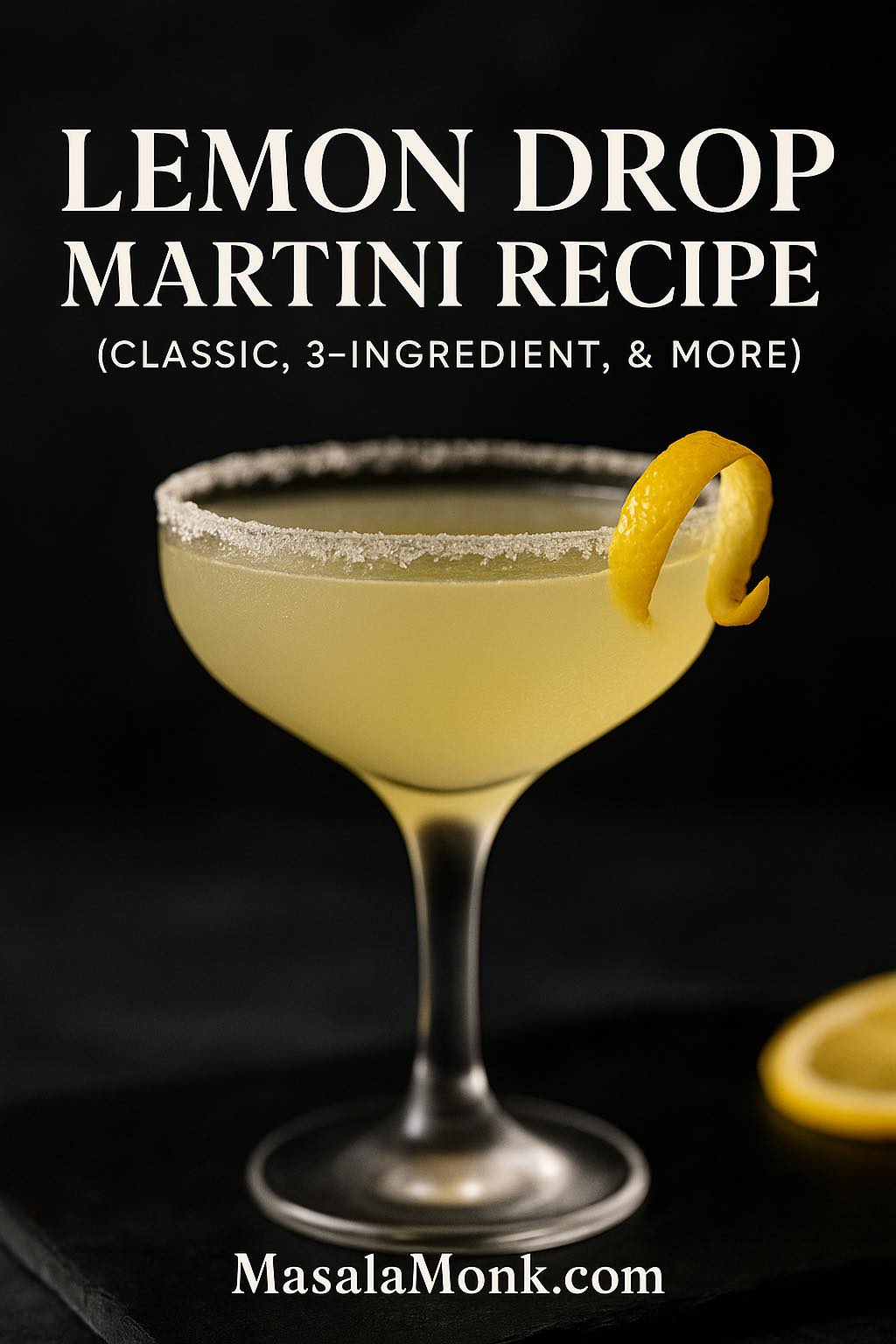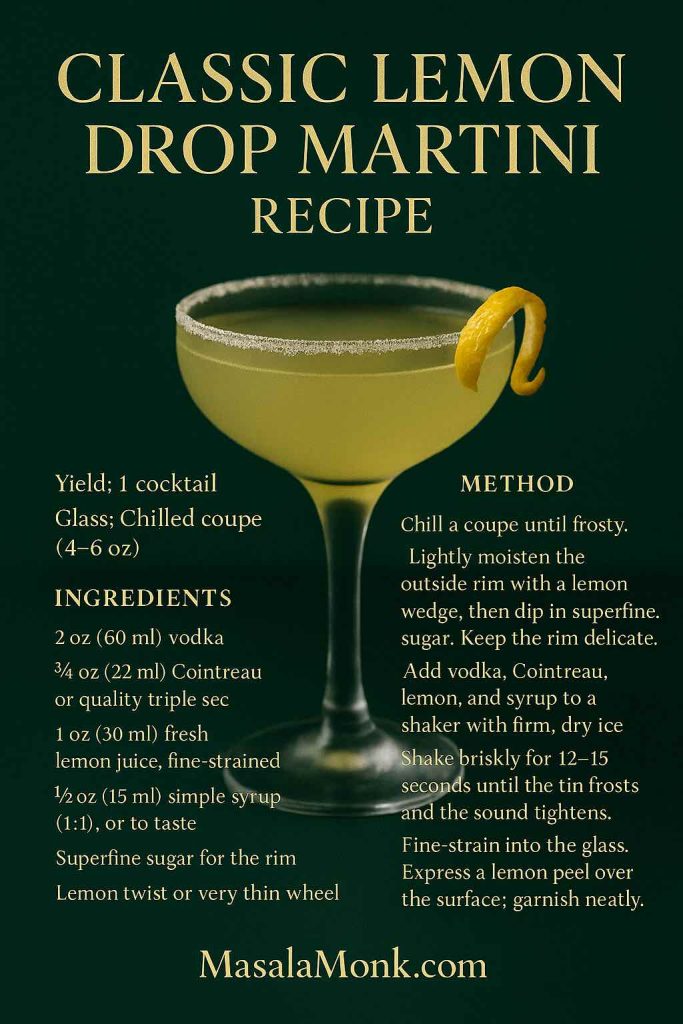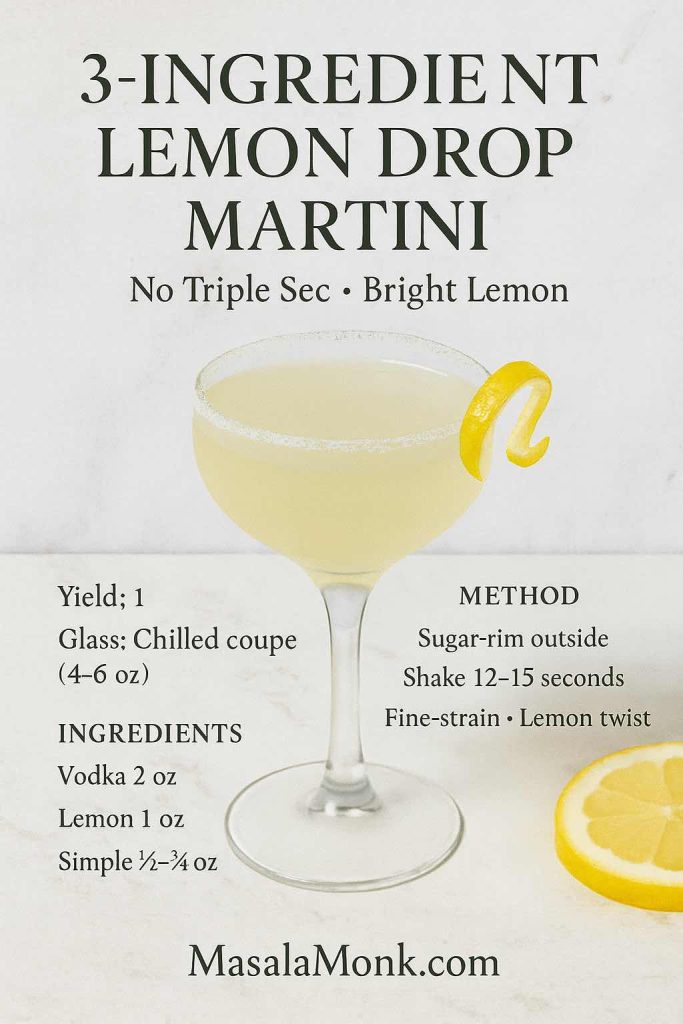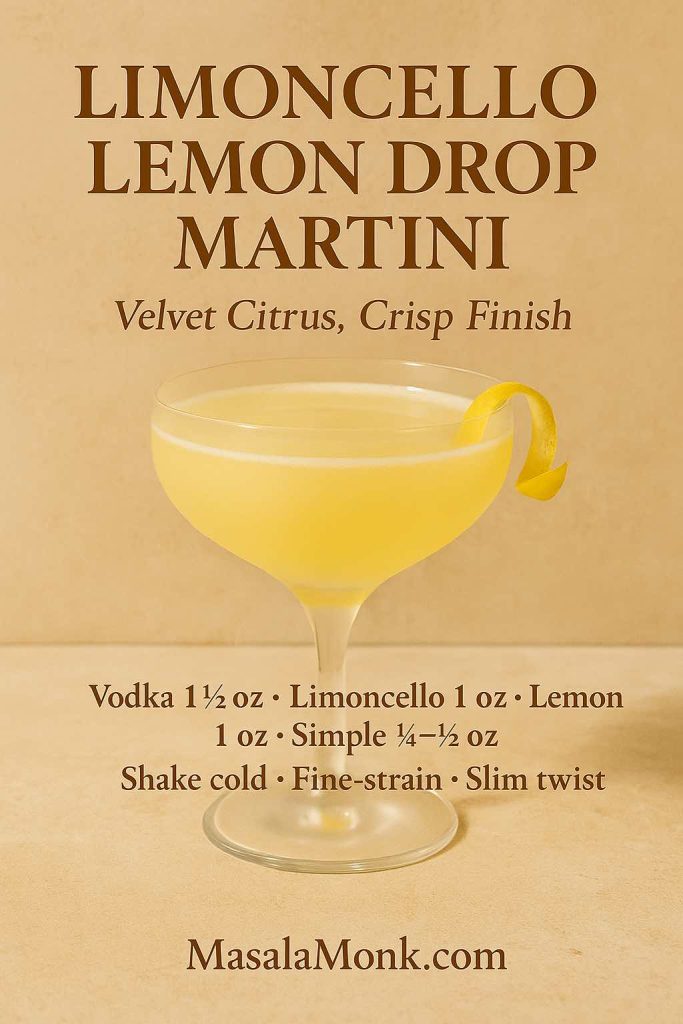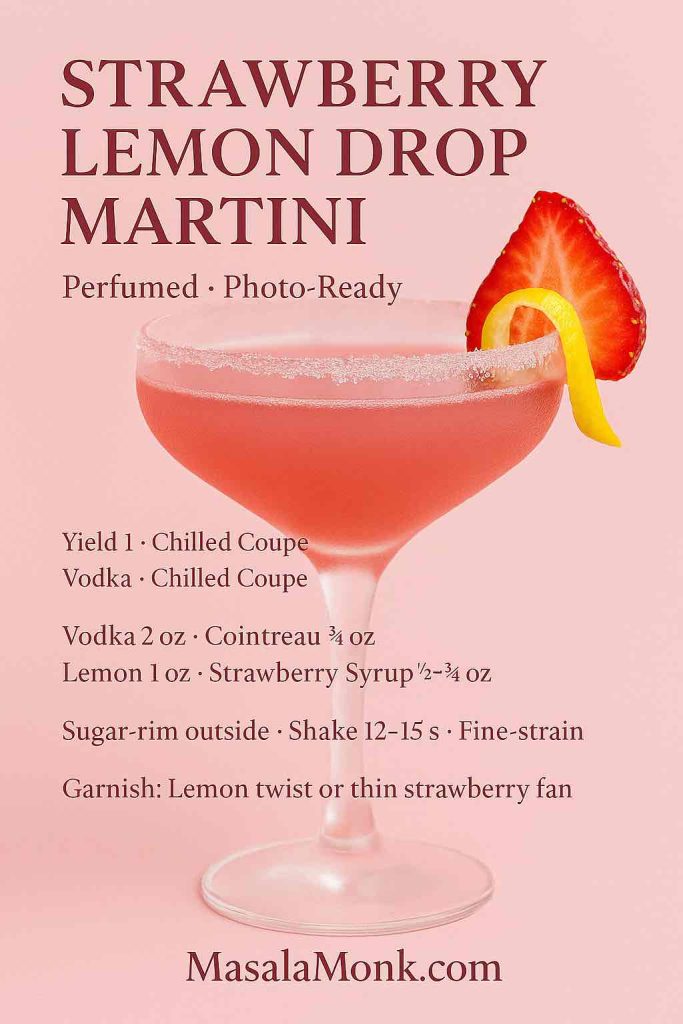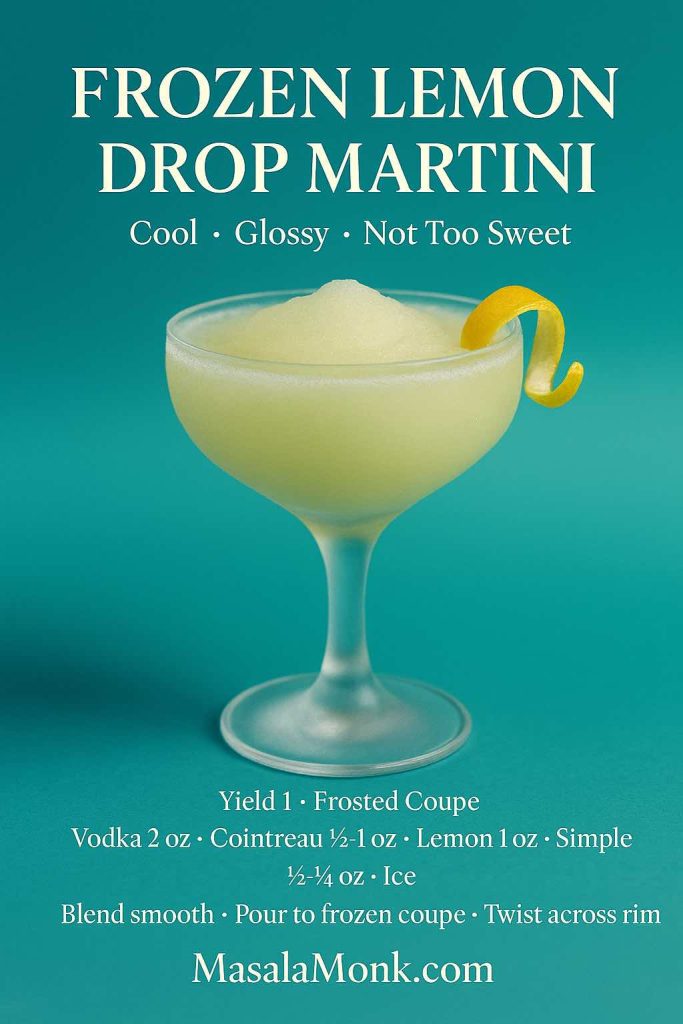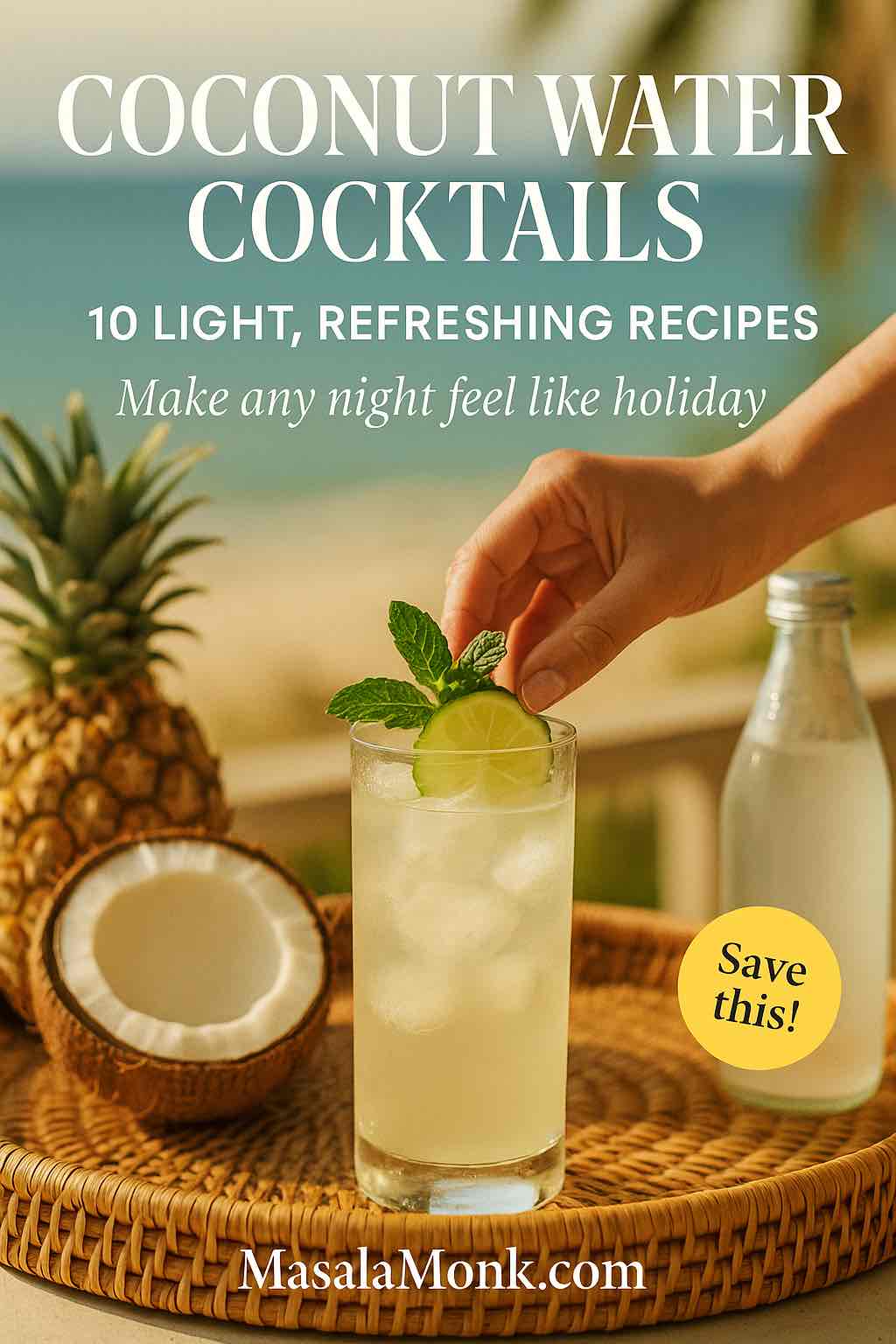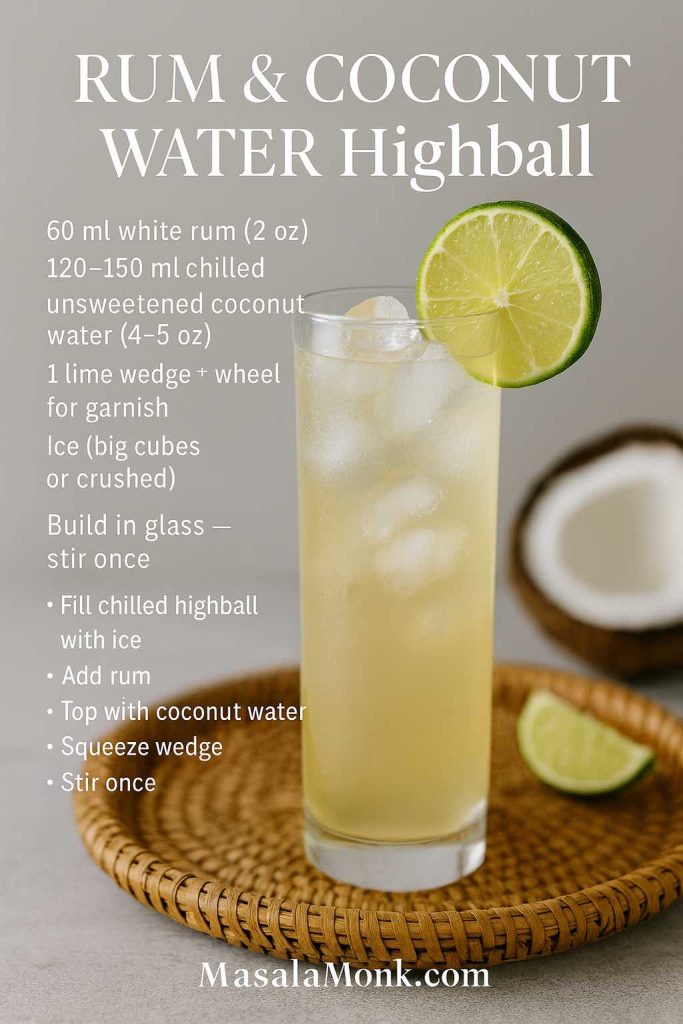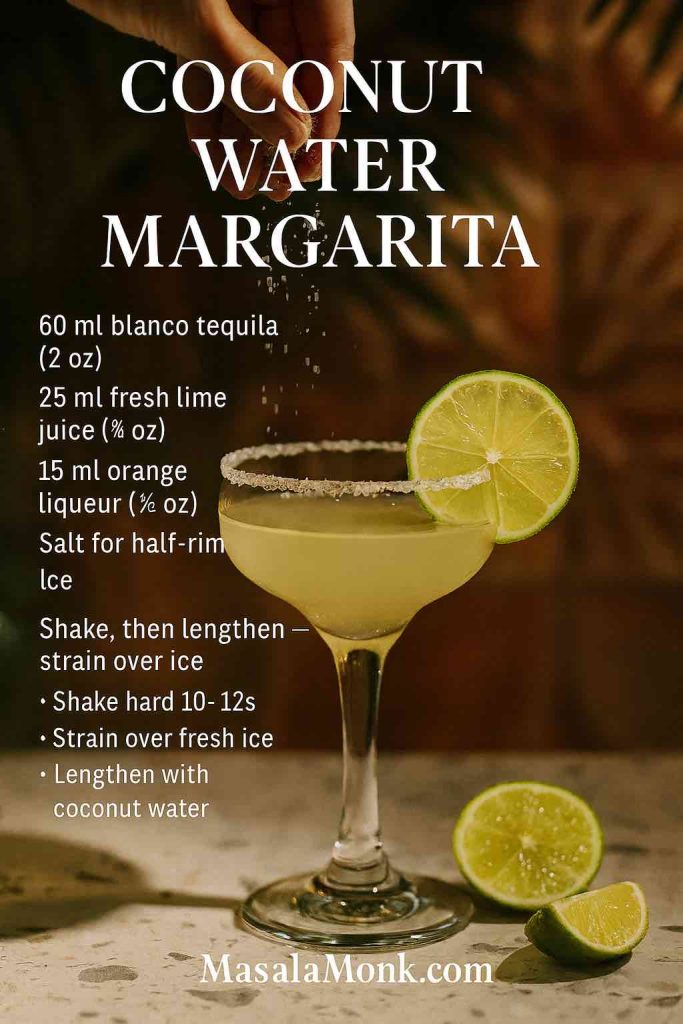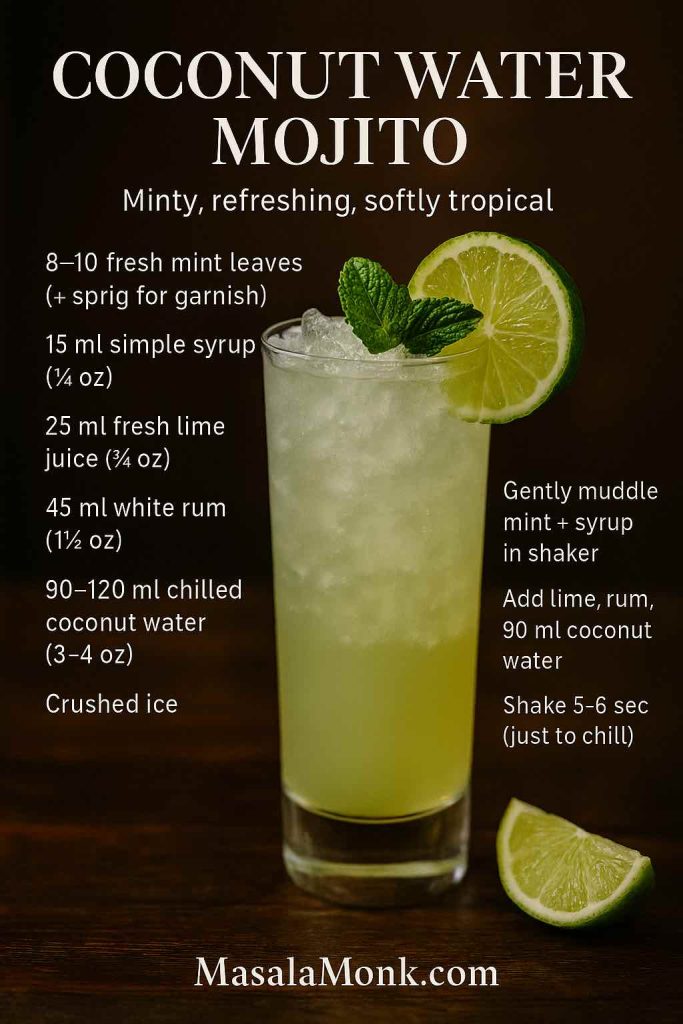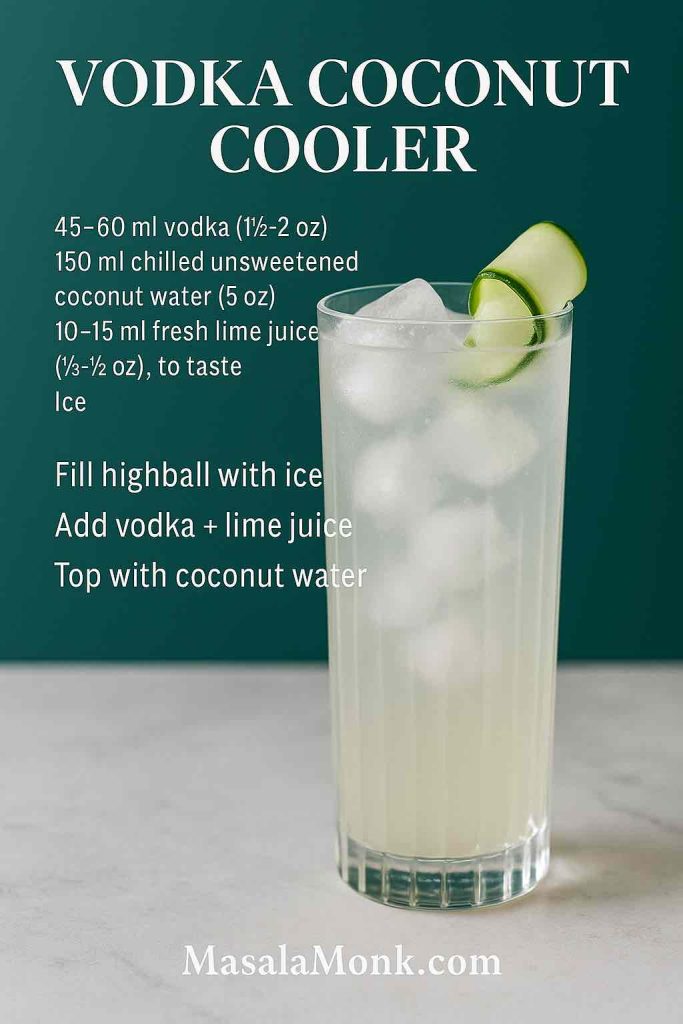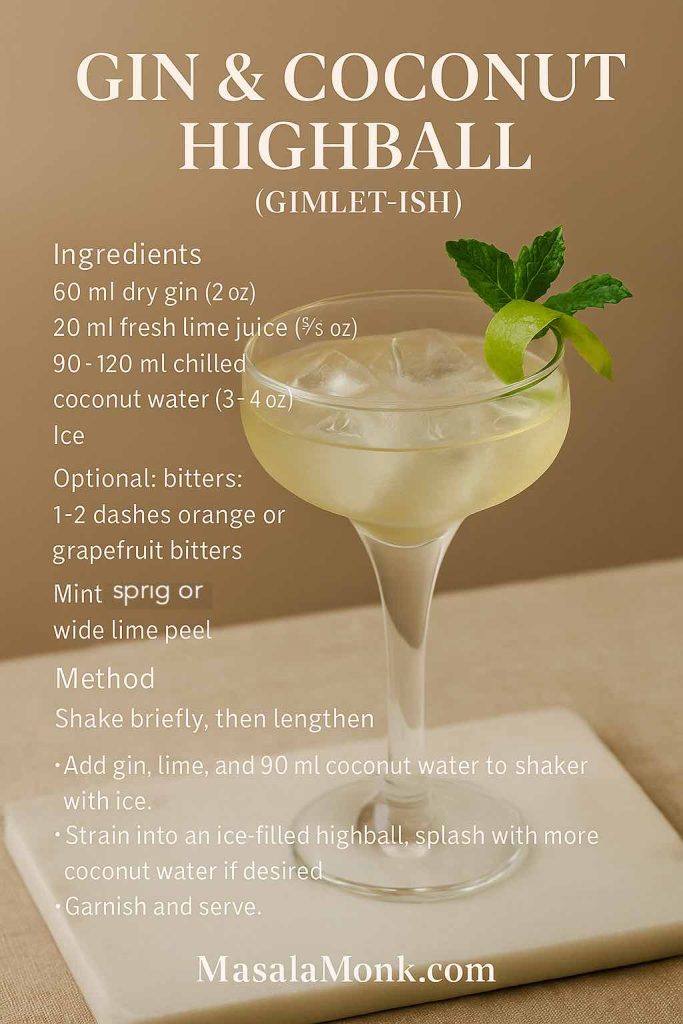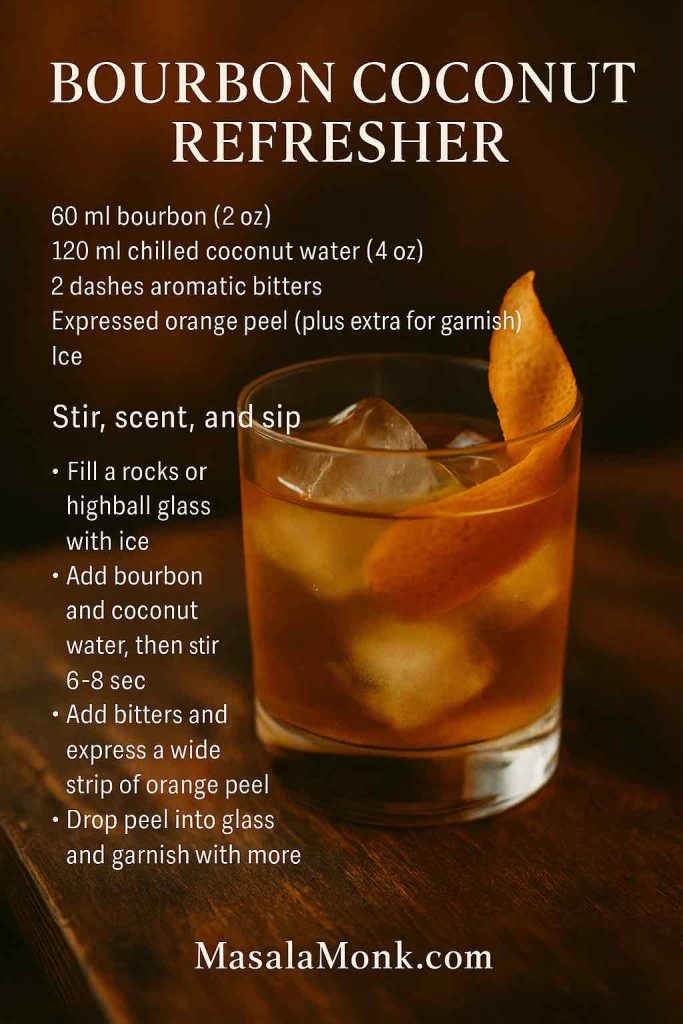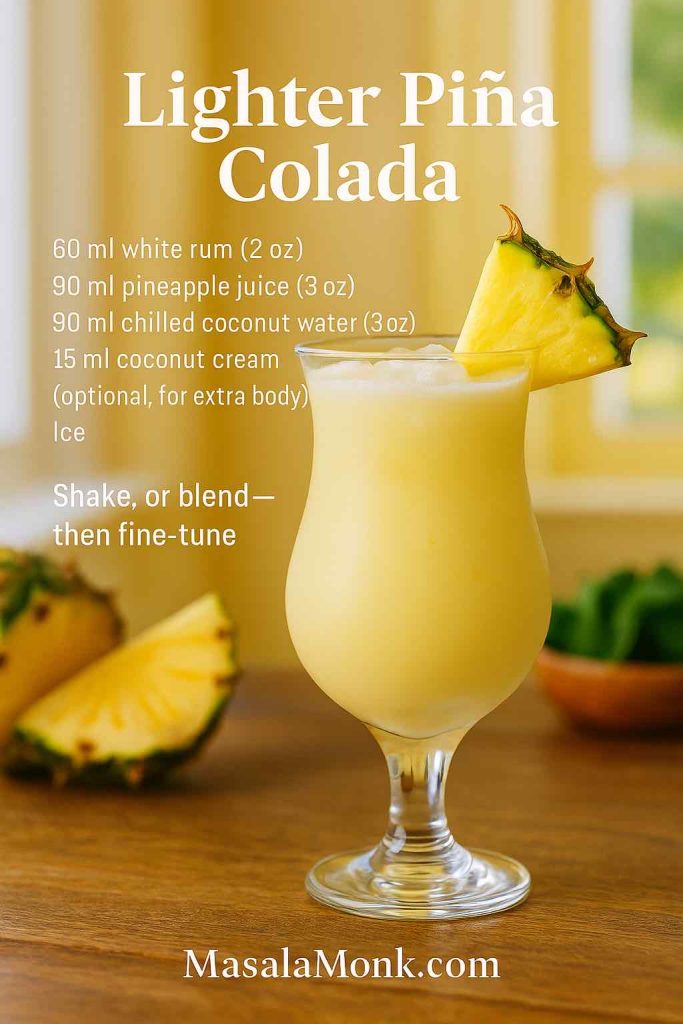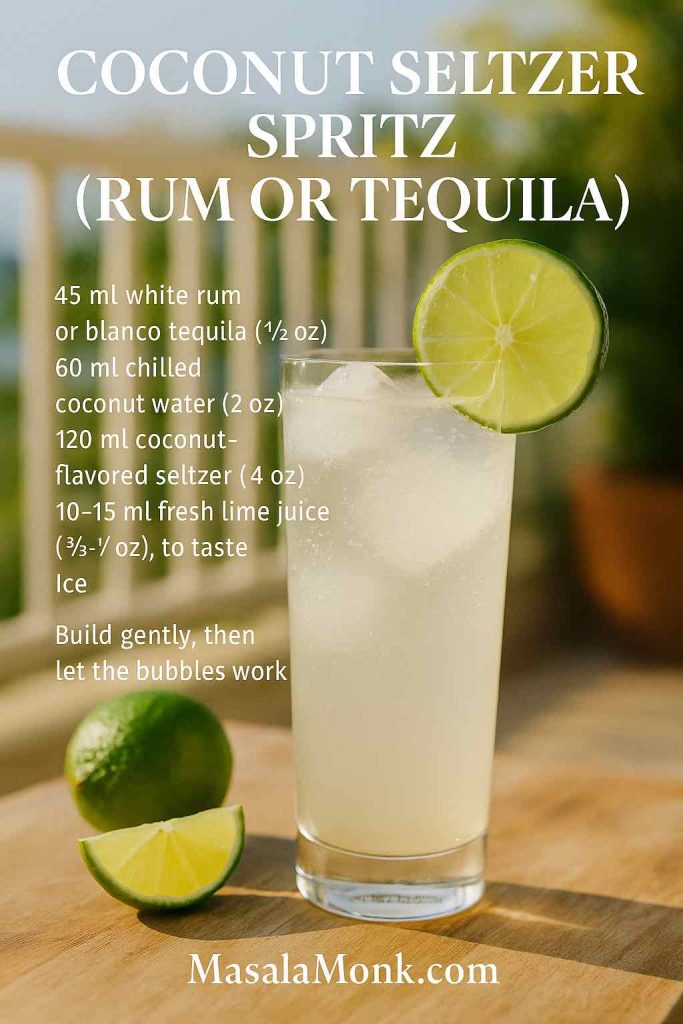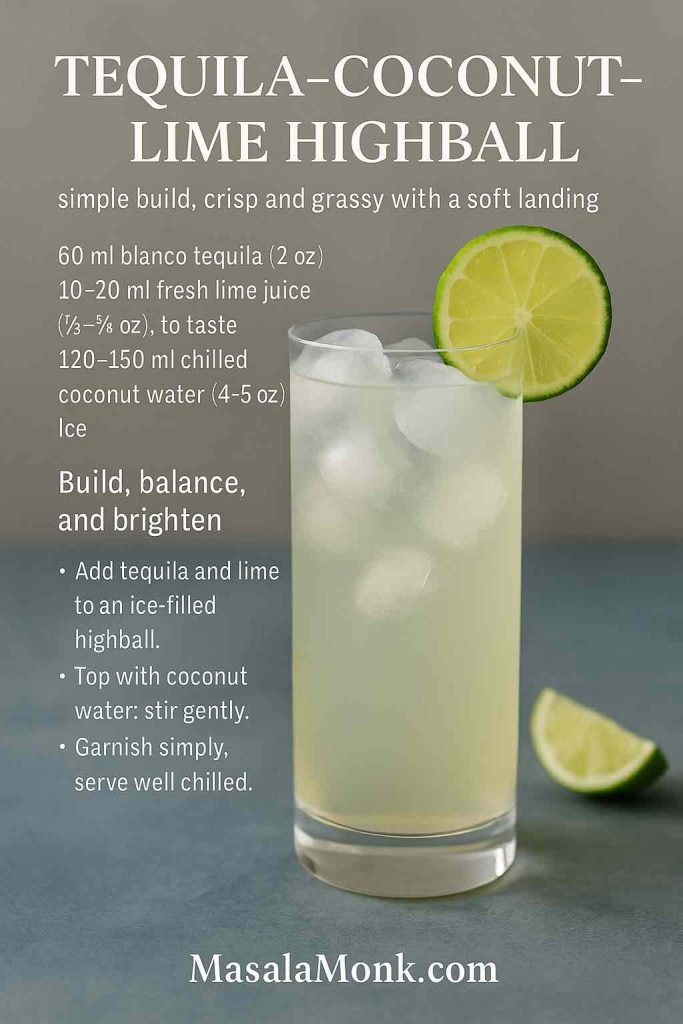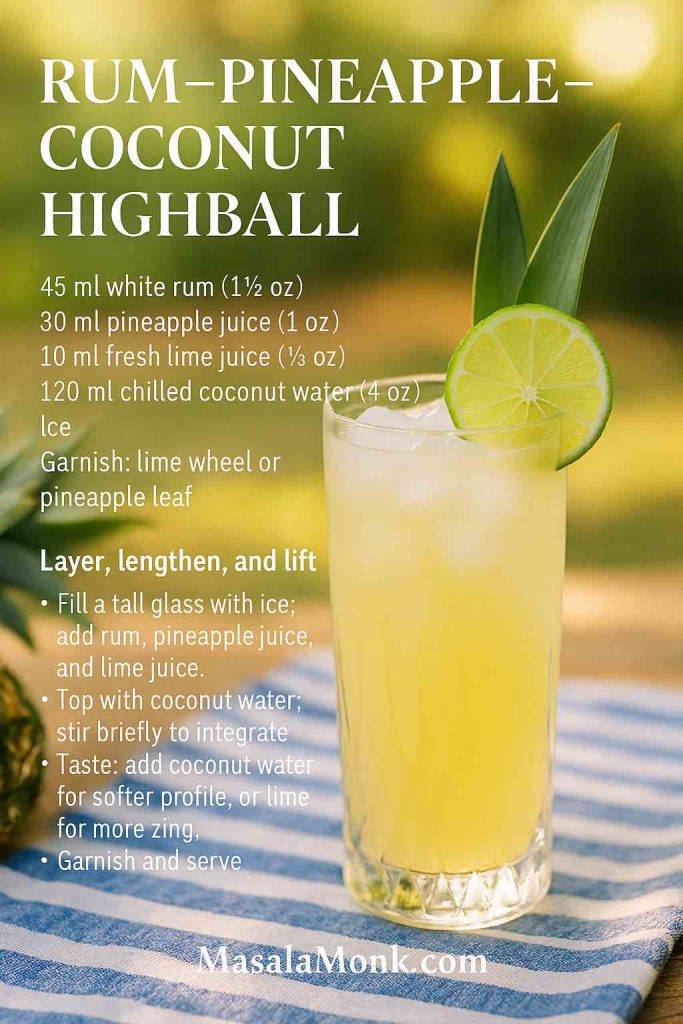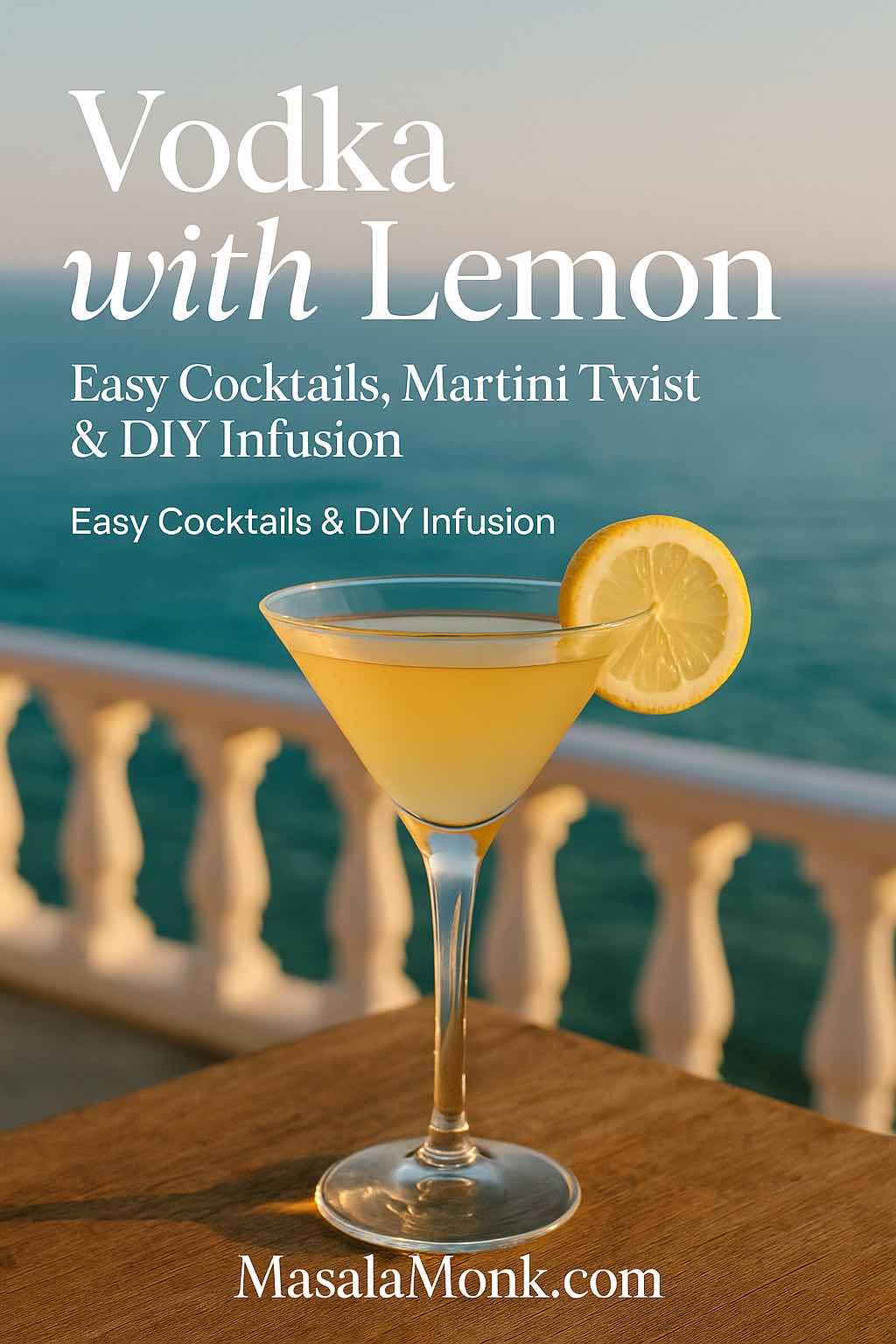
Lemon brightens everything it touches. Vodka, by contrast, steps back and lets flavor lead. Put them together and you get drinks that are crisp, lively, and surprisingly adaptable. One moment it’s a tall, thirst-quenching vodka lemon highball; the next, it’s a flute of bubbles that tastes like celebration. Later, it might be a chilled vodka martini with a lemon twist—clean, perfumed, and impossibly simple. And because technique matters as much as recipes, you’ll also find batching math, ice strategy, saline tips, and a fast lemon-infused vodka you can keep on hand for instant brightness.
If someone at your table asks for a sugar-rim classic—whether it’s a lemon drop martini, a 3-ingredient lemon drop martini, a fruit spin like blueberry lemon drop martini, strawberry lemon drop martini, or raspberry lemon drop martini—send them straight to Lemon Drop Martini Recipe (Classic, 3-Ingredient & More) so this page can focus on everything else vodka + lemon does so well.
Why vodka with lemon works (and how to make it sing)
First, vodka’s neutrality is a feature, not a flaw. Because the base is clean, citrus can shine. Second, lemon offers three distinct tools you can mix and match: juice for tang and structure, peel (the twist) for perfume without extra acidity, and liqueur/infusions for roundness and length. Third, balance usually comes from small moves; therefore, start modestly sweet and nudge in 5 ml steps until flavor snaps into focus.
- Fresh juice tastes brighter and finishes cleaner; squeeze to order whenever you can.
- Twist = aroma delivery. Express oil from a broad strip over spirit-forward drinks—especially martinis—so citrus greets the nose first. If you like seeing it spelled out, skim the garnish note on the IBA Dry Martini page.
- Liqueur/infusions such as limoncello or lemon/citron vodka add softness and length. Used thoughtfully, they deepen flavor without heaviness.
Meanwhile, a pinch of salt (or a few drops of saline) often fixes harshness faster than extra sugar. Likewise, chilled glassware slows dilution; large, solid ice keeps flavors vivid; and fresh soda preserves sparkle. Ultimately, a good lemon and vodka drink should taste bright, not sticky; refreshing, not thin.
Also Read: Daiquiri Recipe (Classic, Strawberry & Frozen Cocktails).
Pantry, tools, and two habits that change everything
You don’t need specialized gear. A jar with a tight lid (as a shaker), a long spoon, a strainer, and a measuring tool are plenty. Even so, two habits matter more than gadgets:
- Chill what you can. Cold ingredients make for cleaner, crisper drinks.
- Measure once, taste twice. Add syrup or lemon in 5 ml nudges; stop the instant balance appears. Consequently, you’ll repeat success effortlessly.
Keep a small bottle of 1:1 simple syrup in the fridge. Store lemons at room temperature to maximize juice; roll before squeezing; strain out pips. Have a few fresh herbs (basil, mint, thyme, rosemary) for aroma without weight.
The Vodka & Lemon Highball Template (fast, tall, and endlessly adjustable)
This is your weekday workhorse—sometimes called a vodka collins drink, sometimes just “vodka & lemon soda.” Either way, it’s the backbone of a thousand porch hours. For a fun structural rabbit hole later, peek at the Collins family overview.
One tall drink
- 60 ml vodka
- 30 ml fresh lemon juice
- 10–15 ml simple syrup
- Ice + cold soda water to top
- Lemon wheel (garnish)
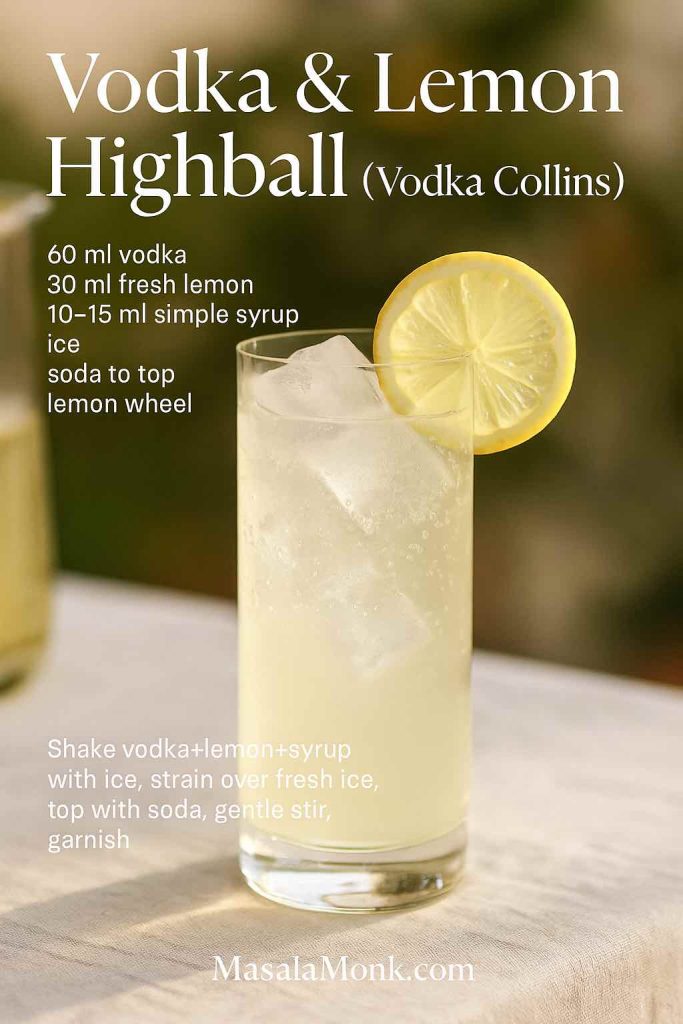
Method
- Chill a Collins or highball glass. Meanwhile, add vodka, lemon, and syrup to a shaker (or jar).
- Shake hard with ice for 8–10 seconds; strain into the cold glass packed with fresh ice.
- Top with soda; give one gentle turn with a barspoon.
- Garnish with a thin lemon wheel; optionally add a cherry for a classic look.
Taste checkpoints
Bright first sip, lively mid-palate, dry-ish finish.
Easy variations
- Herbal: clap 4 basil leaves or 6 mint leaves; drop into the glass before topping.
- Spicy: add 3 paper-thin ginger slices to the shaker.
- Citrus-forward: swap half the vodka for limoncello for a softer edge.
- Citron-style: use lemon-flavored/citron vodka in place of plain if that’s what you have.
Make-ahead
Combine vodka + lemon + syrup in a bottle; chill up to 6 hours. Subsequently, pour 90 ml base per glass and top with cold soda to serve. In short, you gain speed without losing fizz.
If you like a tidy reference spec for the baseline build, here’s Vodka Collins (Difford’s Guide).
French 76 (yes, the “French 75 with vodka”)
This sparkling classic—often looked up as vodka French 75—pairs lemon acidity with bubbles for a celebratory, buoyant sip. It’s the vodka sibling of the gin-based original; for a side-by-side read later, peek at French 76 and the classic French 75.
One flute
- 45–60 ml vodka (use 45 ml for delicate bubbles, 60 ml for a bolder pour)
- 22 ml fresh lemon juice
- 10–15 ml simple syrup
- Dry sparkling wine to top
- Lemon twist or cherry
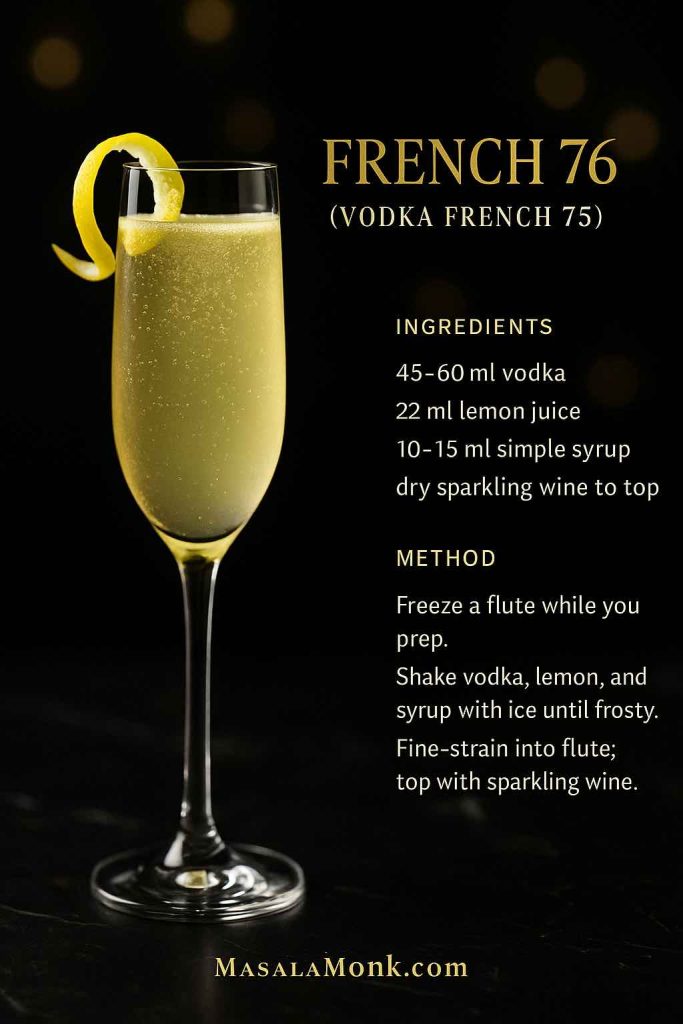
Method
- Freeze a flute while you prep; also keep your bubbles very cold.
- Shake vodka, lemon, and syrup with hard ice until the shaker frosts.
- Fine-strain into the flute; top with sparkling wine gently so the mousse stays lively.
- Garnish with a tight twist; alternatively use a cherry for a vintage nod.
Dial-in guide
- Sharper & drier: 10 ml syrup + extra-dry bubbles.
- Softer & rounder: 15 ml syrup + a fraction more lemon.
- Brunch pitcher: pre-mix the still base (vodka, lemon, syrup) in a swing-top, chill thoroughly, and pour 60 ml per glass before topping with bubbles at the table.
Also Read: Piña Colada: Classic Recipe + 10 Variations (Virgin & On the Rocks).
Limoncello Martini (silky, perfumed, balanced)
This isn’t a lemon drop; it’s a smoother, subtler cousin. Because limoncello brings softness while fresh lemon contributes lift, you get dessert-adjacent pleasure without a sugar rim. If you enjoy parallel home-kitchen guidance, skim Limoncello Martini (The Kitchn) afterward.
One coupe
- 45 ml vodka
- 45 ml limoncello
- 22 ml fresh lemon juice
- 0–15 ml simple syrup, to taste (often unnecessary)
- Broad lemon peel
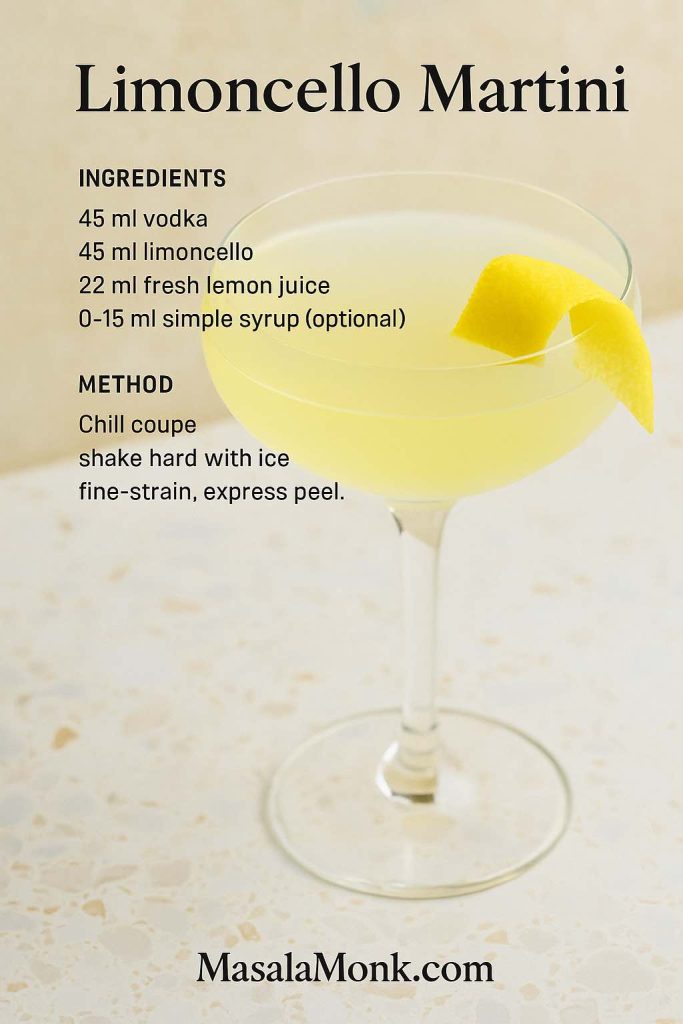
Method
- Chill a coupe until frosty.
- Shake vodka, limoncello, and lemon hard with plenty of ice; fine-strain.
- Express a broad peel over the surface; drop or discard.
Adjustments
- If the limoncello is sweet, skip the syrup.
- If the lemon is punchy, add 5 ml syrup and shake again.
- If the drink feels sleepy, increase lemon by 5 ml or split the base (40 ml vodka / 50 ml limoncello) for extra perfume.
Also Read: Punch with Pineapple Juice: Guide & 9 Party-Perfect Recipes.
Dry Vodka Martini with a Lemon Twist (minimalism done right)
Sometimes all you want is purity: spirit, a measured hint of vermouth, and the aroma of fresh lemon oil. The classic garnish technique—expressing oil from the peel—is captured neatly on the IBA Dry Martini page.
One martini
- 60 ml vodka
- 10–15 ml dry vermouth
- Wide strip of lemon peel
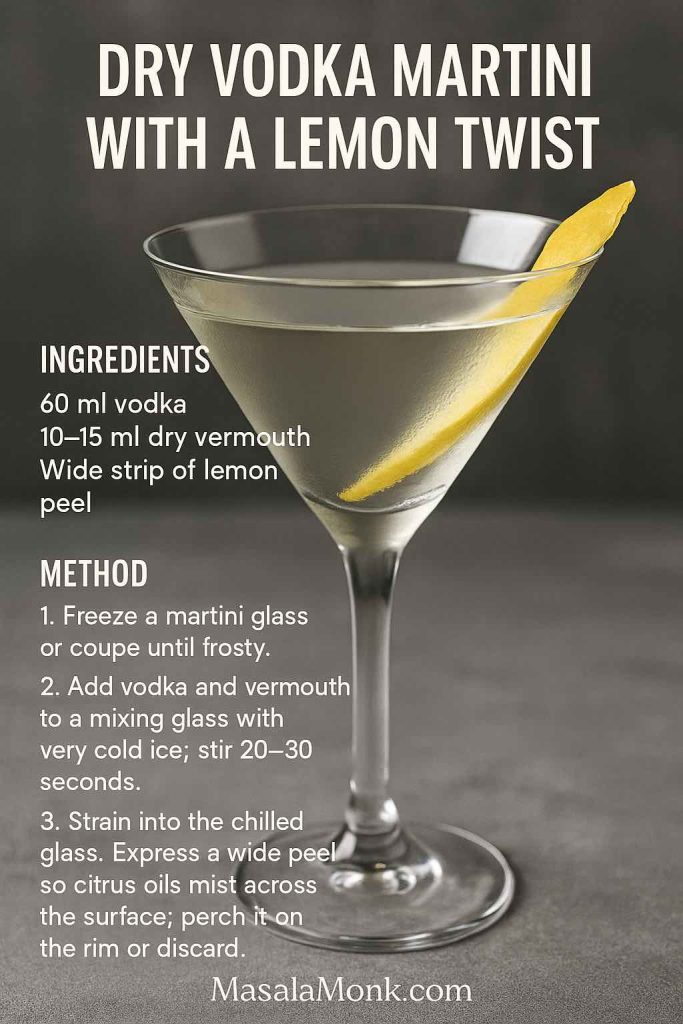
Method
- Freeze a martini glass or coupe until frosty.
- Add vodka and vermouth to a mixing glass with very cold ice; stir 20–30 seconds.
- Strain into the chilled glass.
- Express a wide peel so citrus oils mist across the surface; perch it on the rim or discard.
Tuning
- Extra-dry: 5 ml vermouth or a quick glass rinse.
- Silkier: stir a few seconds longer for a colder, slightly wetter texture.
- Sharper nose: twist a fresh piece of peel right before the first sip.
Lemon-Infused Vodka (24–72 hours, bright not bitter)
Ready-made lemon vodkas exist—lemon-flavored vodka, citrus vodka, citron vodka, and so on. Nevertheless, a quick homemade lemon infusion tastes fresher and lets you control intensity. Plus, it’s the easiest way to make a weeknight lemon vodka drink feel special. To avoid common pitfalls like bitterness or over-extraction, two useful reads later are Common infusion mistakes and How to infuse vodka.
Yields ~700 ml | Active time 10 minutes | Steep 24–72 hours
You’ll need
- 5–6 wax-free lemons, well washed
- 700 ml neutral vodka (40% ABV)
- Peeler, clean jar, fine strainer (coffee filter optional)
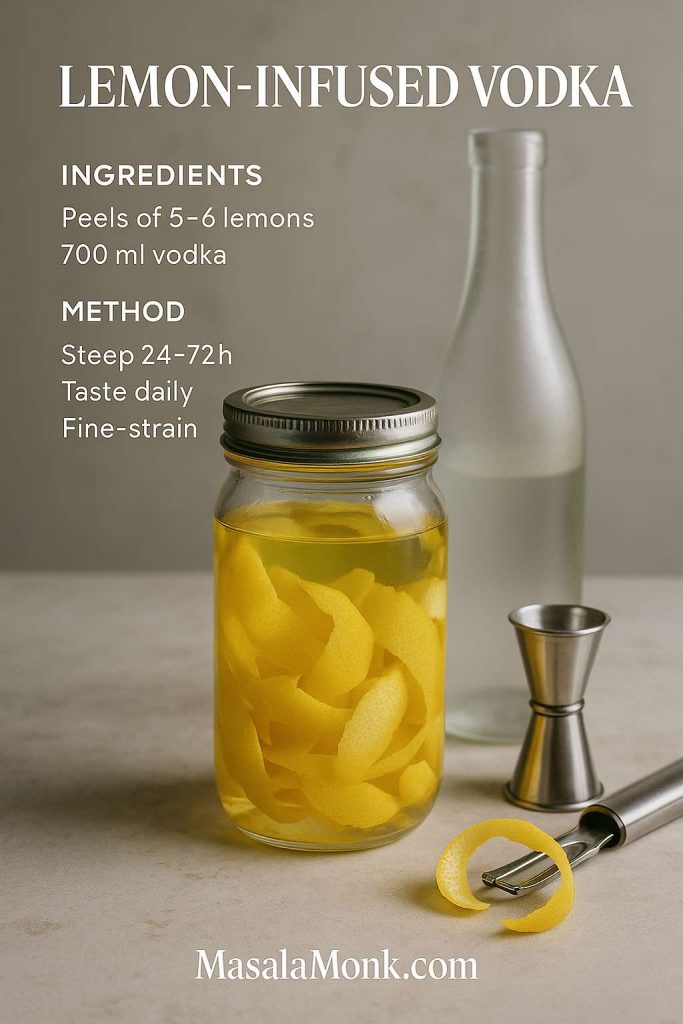
Method
- Zest only: peel just the yellow skin; avoid white pith or bitterness will creep in.
- Combine: put zest in the jar; cover fully with vodka; seal.
- Infuse: store cool and dark; taste at 24, 36, 48 hours; stop anywhere up to 72 hours when it’s vivid but not perfumey.
- Finish: fine-strain; optionally filter once through a coffee filter for clarity; bottle; chill.
Three instant serves
- Lemon Vodka & Soda: 60 ml infused vodka over ice, top with soda, squeeze a lemon wedge.
- Zesty Collins: 45 ml infused vodka + 20 ml lemon + 10 ml simple; shake; strain; top with soda.
- Five-Minute Martini: 60 ml infused vodka stirred on ice; strain; finish with a tiny twist.
Cordial path
Stir in simple syrup to taste and label it “lemon vodka cordial.” Then pour over ice, top with soda, or fold into a quick lemon vodka martini whenever you like.
Fixes
- Bitter: pith sneaked in or you steeped too long—dilute with plain vodka and filter again.
- Perfumey: stop immediately; use smaller pours.
- Cloudy: coffee-filter; store cold; haze usually settles.
Also Read: What to Mix with Jim Beam: Best Mixers & Easy Cocktails.
Basil Lemon Vodka Lemonade (single-serve & pitcher)
Easy, fragrant, and tailor-made for porch weather.
One tall glass
- 60 ml vodka
- 90–120 ml quality lemonade
- 4–6 basil leaves (plus a sprig for garnish)
- Ice, lemon wheel
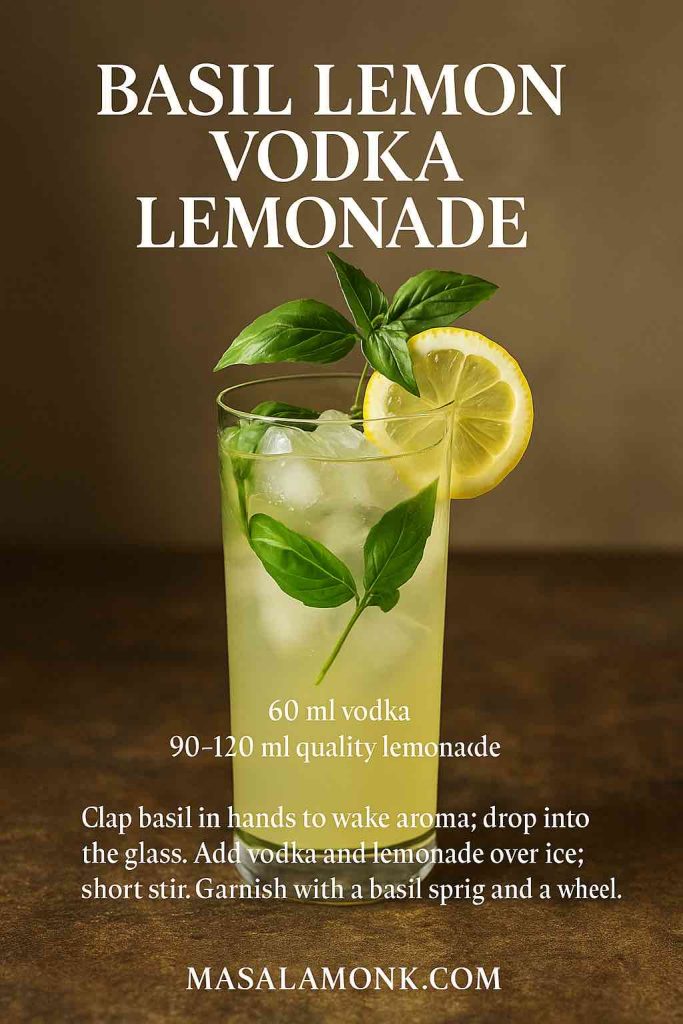
Method
- Clap basil in your hands to wake aroma; drop into the glass.
- Add vodka and lemonade over ice; short stir.
- Garnish with a basil sprig and a wheel.
Pitcher (serves 8)
- 480 ml vodka
- 1 L lemonade
- A generous handful of basil, lightly bruised
- Ice or a large block
Combine in a jug, stir gently, and serve. If your lemonade leans bitter, let the basil sit only ten minutes; strain it out so the flavor stays clean rather than herbal-bitter.
Riffs
Cucumber slices for spa-day coolness; strawberries for color and perfume (reduce sweetness elsewhere); a soda top if the lemonade is heavy. If the crowd likes fruit-first spins, they’ll also enjoy Mango Vodka Cocktail Drinks (base + 7 variations) next.
Lavender Lemon Vodka Spritz (light, floral, effortless)
Delicate and brunch-friendly, this reads like a citrusy breeze. Lavender is potent; go easy.
One wine glass
- 45 ml vodka
- 15 ml lavender syrup
- 22 ml fresh lemon
- Cold soda to top
- Lemon wheel, tiny lavender sprig
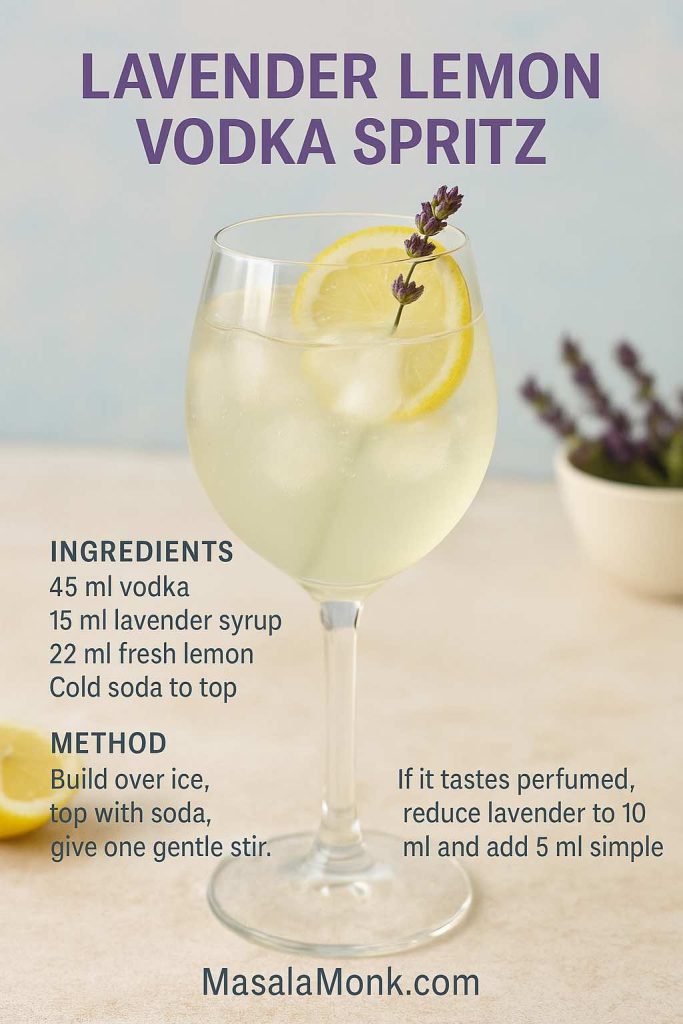
Method
Build over ice; top with soda; give one gentle stir. If it tastes perfumed, reduce lavender to 10 ml and add 5 ml simple to maintain balance. If it tastes sharp, increase lavender by 5 ml or simply top with a bigger soda splash.
Zero-proof lane
Omit vodka, double the soda, and keep the lemon + lavender. The glass still smells fantastic, and the sip stays bright.
Also Read: Whiskey and Warmth: 5 Cinnamon-Spiced Iced Tea Cocktails to Get You through Wednesday
Lemon Iced-Tea Vodka Highball (cool, calm, porch-ready)
This is iced tea with manners. Because you choose the tea’s sweetness, you choose the drink’s vibe.
One tall glass
- 60 ml vodka
- 120–150 ml chilled lemon iced tea (unsweetened or lightly sweet)
- Squeeze of lemon
- Tiny pinch of salt (optional)
- Lemon wedge, mint sprig
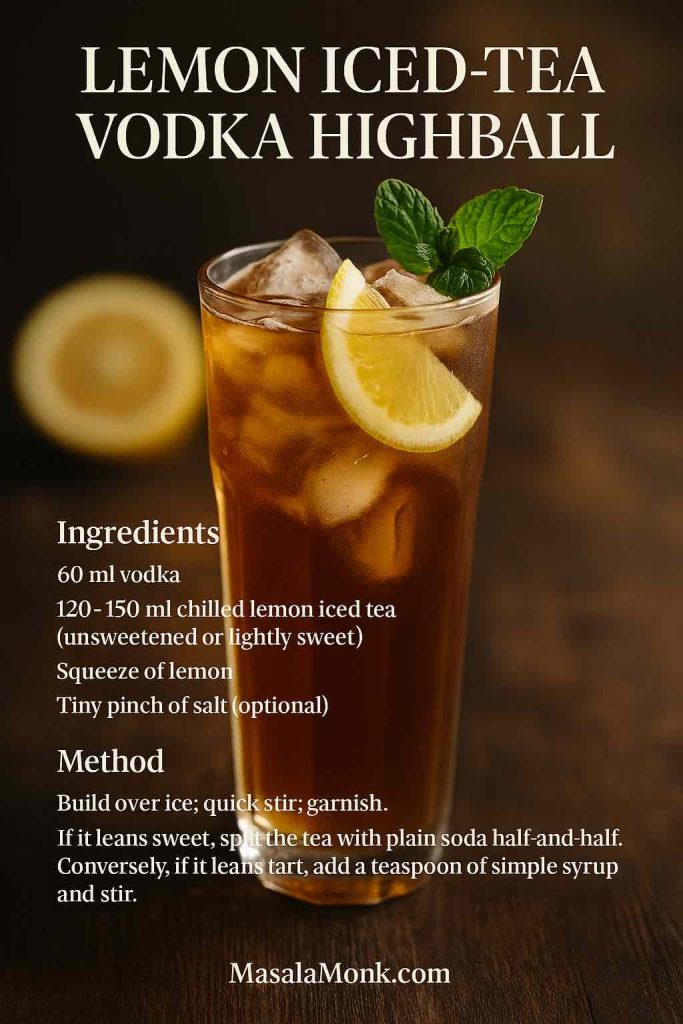
Method
Build over ice; quick stir; garnish. If it leans sweet, split the tea with plain soda half-and-half. Conversely, if it leans tart, add a teaspoon of simple syrup and stir. For similar “fresh and light” energy, browse Coconut Water Cocktails.
Pitcher
- 480 ml vodka + 1 L iced tea in a large jug over plenty of ice; guests tune tartness with wedges at the table.
Also Read: Electrolyte Drinks for Hangovers: 5 Easy DIY Recipes to Rehydrate Fast.
Balance & Dilution (the quiet secrets behind great lemon drinks)
Because lemon pushes acidity, small moves matter. Think in 5 ml increments for syrup and lemon. Aim for cold at every step—spirits, glass, and soda—to manage dilution without losing liveliness.
- Sugar vs. acid: if a sip stings, add 5 ml syrup; if it drags, add 5 ml lemon.
- Salt vs. bitterness: a tiny pinch (or 2–4 drops of 10% saline) smooths harsh notes without making the drink taste salty.
- Ice: large, clear cubes melt slower; crushed ice is ideal for smashes but expect faster dilution.
- Glass choice: tall for highballs (keeps bubbles lively), stemmed for spritzes (captures aroma), chilled coupes for martinis (keeps texture silky).
- Soda timing: pour carbonated things last, then stir once—no more.
Crowd-Pleasing Pitchers (because friends actually show up)
Batches should feel fresh, not flat. Mix the base early, keep it cold, and add bubbly things at the last second.
Sparkling Vodka Lemon Pitcher (serves 8)
Base
- 480 ml vodka
- 240 ml fresh lemon juice
- 120–160 ml simple syrup (start at 120; adjust to taste)
To serve
- Dry sparkling wine (or very cold soda water)
- Paper-thin lemon wheels
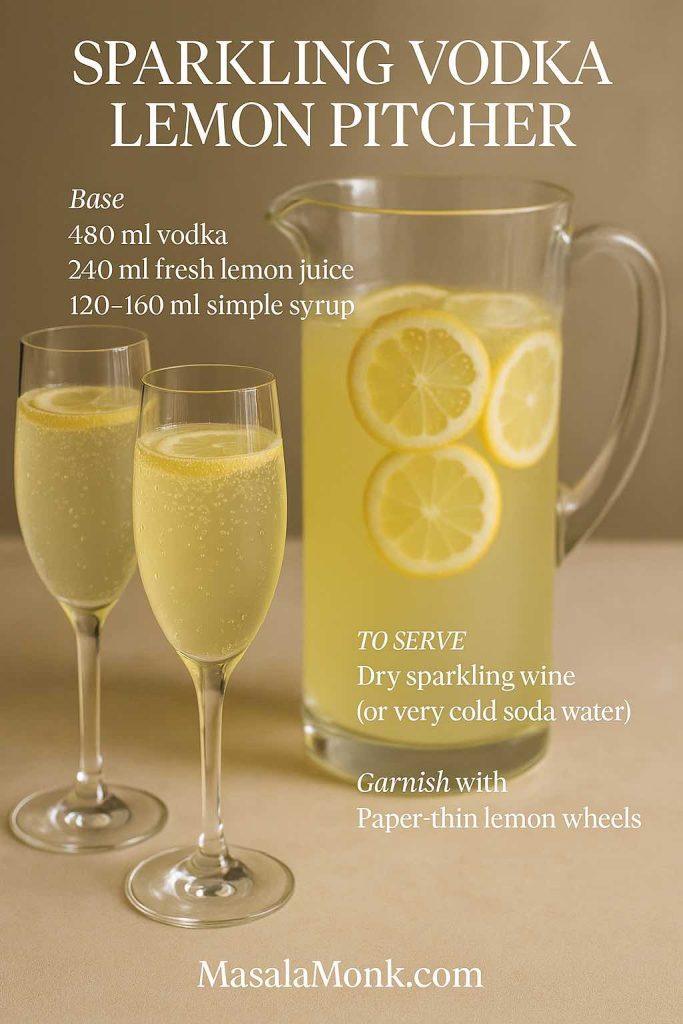
Method
- Chill a 1.5–2 L jug and your bubbles.
- Stir the base; refrigerate at least 1 hour.
- Add ice to flutes or wine glasses; measure 60 ml base per glass; top with bubbles.
- Garnish with lemon wheels.
Why it works
Bubbles carry aroma and emphasize brightness; therefore, you can sweeten modestly and still feel rounded. For serving style cues and historical notes, compare French 76 and French 75.
Basil Lemonade Vodka Pitcher (serves 8–10)
Base
- 480 ml vodka
- 1 L quality lemonade
- 1 generous handful basil, lightly bruised
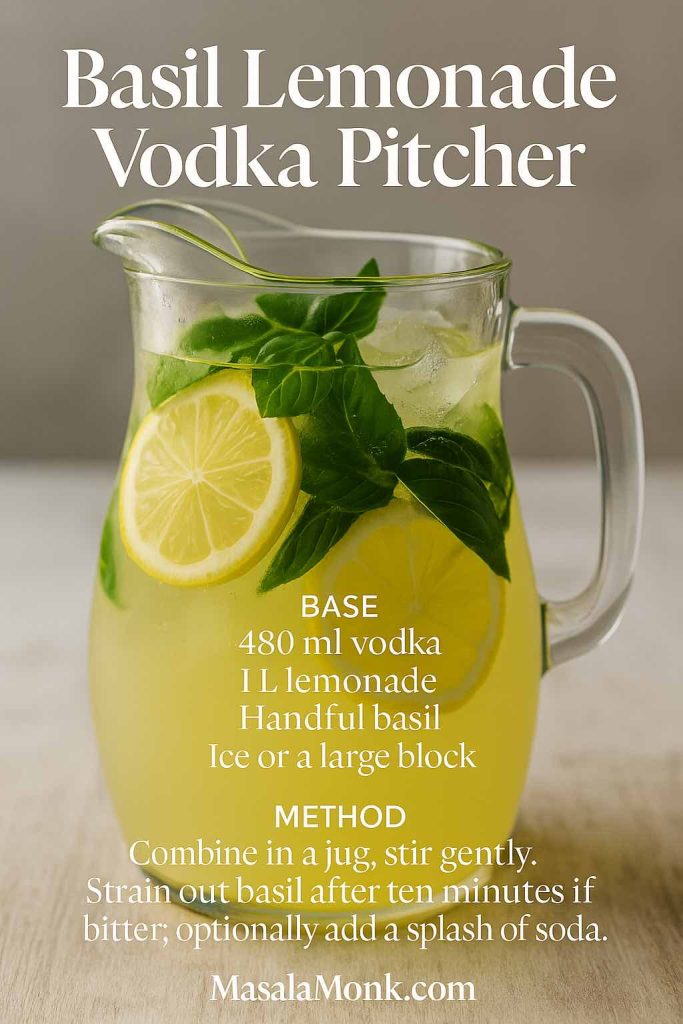
Method
Combine in a large jug over a big block of ice. Clap basil between your hands and drop it in. Stir gently. Serve tall; optionally top individual glasses with a splash of soda for extra lift.
Riffs
- Cucumber slices for spa freshness.
- Quartered strawberries for aroma and color (reduce sweetness elsewhere if your lemonade is sugary).
- Mint instead of basil when you want a cooler finish.
Another bright detour
When you want a non-alcoholic base your guests can spike per glass, Mango Lemonade is a crowd favorite.
Small details that make lemon shine
- Squeeze to order: lemon dulls as it rests; fresh wins.
- Use large, clear ice when possible: slower melt, steadier flavor.
- Lead with aroma: express lemon oil over spirit-forward drinks so your nose gets citrus first.
- Season gently: a tiny pinch of salt often balances faster than extra sugar.
- Garnish intentionally: slim wheels look neat in tall glasses; broad peels make martinis sing.
Also Read: Top 12 Hangover Remedies from Around the World.
Regional and dietary notes
- If lemons are small or extra tart: start 5 ml lower on lemon, then nudge up.
- If keeping soda cold is tricky: freeze glasses, use big cubes, and pour soda last—immediately before serving.
- If you prefer fewer calories: favor soda-topped builds, lighten syrup, and rely on herbs for aroma.
- If you avoid honey: in the honey-lemon variations, swap agave 1:1 and retaste.
- If you want zero-proof options: replace vodka with soda, keep lemon and syrup, and garnish generously so the glass still feels special.
Troubleshooting without panic
- Too sour? Add 5 ml syrup, stir, retaste.
- Too sweet? Add 5–10 ml lemon and a small splash of soda.
- Too watery? Your glass or ice was warm—chill glassware and use fresh, solid cubes next time.
- Too bitter? Pith sneaked in or infusion went long; add a pinch of salt and a small soda top.
- Too flat? Always use freshly opened, very cold soda or bubbles and pour them last.
Keep exploring
If this page becomes your weeknight playbook, bookmark it. When somebody asks for the sugar-rim icon (including fruit, pink, lavender, frozen, or “skinny” spins), jump to Lemon Drop Martini Recipe (Classic, 3-Ingredient & More). If the table wants more fruit-first long drinks afterward, wander through Mango Vodka Cocktail Drinks and Coconut Water Cocktails. And for garnish craft, skim the lemon-oil note inside the IBA Dry Martini entry; it’s tiny, yet it changes every martini you’ll ever make.
FAQs
1) What’s the simplest way to make vodka with lemon at home?
Start with the Collins template: 60 ml vodka, 30 ml fresh lemon juice, and 10–15 ml simple syrup; then top with cold soda. Consequently, you’ll get a bright, balanced lemon vodka drink without fuss. Moreover, you can swap plain vodka for a citrus vodka or lemon infused vodka if you want extra aroma.
2) How do I balance sourness and sweetness in a vodka & lemon cocktail?
Begin modestly sweet, taste, and adjust in 5 ml nudges. If it’s too sharp, add a little syrup; alternatively, if it feels dull, add a small squeeze of lemon. Furthermore, a tiny pinch of salt can soften bitterness—therefore, reach for salt before adding more sugar.
3) Which vodka style works best for a lemon-forward drink?
Neutral, clean vodkas let citrus shine; however, if you prefer a rounder profile, try citron vodka or other lemon flavored vodka. Additionally, for a perfumed, dessert-leaning direction, limoncello (see limoncello martini) adds silky citrus depth.
4) What exactly is a Vodka Collins drink?
It’s the vodka version of a Collins: spirit + lemon + sugar + soda. As a result, you’ll get a tall, refreshing vodka lemon highball that’s easy to tune. Meanwhile, herbs like basil or mint slip in beautifully without weighing the drink down.
5) How is a French 76 different from a French 75 with vodka?
Strictly speaking, the French 76 is the recognized “vodka French 75.” The original French 75 uses gin; the 76 swaps in vodka. Consequently, the lemon reads cleaner, while the bubbles stay central. For brunch, pre-mix the still base and, afterward, top with sparkling wine to keep the mousse lively.
6) Can I make a vodka martini with a lemon twist instead of olives?
Absolutely. In fact, a vodka martini with a twist (i.e., lemon) emphasizes aroma rather than brine. Stir 60 ml vodka with 10–15 ml dry vermouth until very cold; then strain and express lemon oil across the surface. Notably, that quick twist transforms the first sip.
7) What’s the difference between a lemon drop martini and a lemon vodka martini?
A lemon drop martini is sweet-tart and often sugar-rimmed; a lemon vodka martini (with or without limoncello) can be drier, silkier, and more spirit-forward. Moreover, while the lemon drop leans toward dessert, the drier martini reads elegant and aperitif-like.
8) Is a 3-ingredient lemon drop martini actually worth making?
Yes—vodka, lemon juice, and simple syrup are enough. However, many bartenders optionally add orange liqueur for complexity. Even so, the three-ingredient build ranks because it’s fast, consistent, and—most importantly—bright. If you want stronger lemon character, use lemon drop martini with vodka plus a lemon twist.
9) Can I use limoncello in a lemon drop or should I make a limoncello martini instead?
You can go either way. On one hand, lemon drop martini limoncello riffs add plushness to the classic. On the other, a dedicated limoncello martini (vodka + limoncello + lemon) feels round and elegant without needing a sugar rim. Ultimately, choose based on how sweet you want the finish.
10) What fruits pair best with vodka and lemon?
Berries love lemon. Consequently, blueberry lemon vodka drink, strawberry lemon vodka, and raspberry variations all sing. Additionally, cucumber offers spa-like freshness, while ginger adds zip. Therefore, experiment by muddling a few slices or berries; then adjust sweetness down by 5 ml if the fruit is already sweet.
11) How do I make lemon infused vodka without bitterness?
Peel only the yellow zest—avoid white pith—then steep 24–72 hours, tasting daily. Furthermore, store the jar in a cool, dark place and stop when the aroma turns vivid but not perfumey. Finally, fine-strain (and, if needed, coffee-filter) for a clear, bright lemon infused vodka ready for spritzes, Collins builds, or a five-minute martini.
12) Which is “better” for lemon drinks: plain vodka or citron vodka (e.g., Absolut Citron)?
It depends. Plain vodka gives you a blank canvas; citron vodka (including absolut citron–style profiles) offers built-in citrus perfume. Consequently, for a quick lemon drop vodka drink, citron provides extra pop; meanwhile, for a clean vodka martini with lemon twist, many prefer plain vodka so the fresh peel leads.
13) How do I keep a pitcher of vodka with lemon from going flat?
Mix only the still base—vodka, lemon juice, and sweetener—then chill hard. Subsequently, add soda or sparkling wine in each glass, not in the jug. As a result, you preserve fizz. Additionally, keep the pitcher on a large ice block so dilution stays controlled through the party.
14) What’s the easiest “skinny” path for vodka and lemon?
Go tall, go sparkling, and keep syrup minimal. For instance, build a Collins with 60 ml vodka, 30 ml lemon, 5–10 ml syrup, and lots of soda. Moreover, garnish with an aromatic twist so it feels generous even with fewer calories.
15) Can I swap lime for lemon in these recipes?
Certainly; nevertheless, expect a different personality. Lime reads sharper and slightly bitter-pithy; lemon feels sunnier and more linear. Therefore, if you swap, adjust syrup by 5 ml and taste again. Meanwhile, a lemon twist on a lime build is a fun mixed-citrus surprise.
16) What’s the trick to the perfect lemon twist for a martini?
Cut a broad strip with minimal pith; then, right over the glass, pinch the peel so oils spray the surface. Next, swipe the rim lightly with the peel; finally, drop it in or discard. Consequently, the first sip smells like fresh citrus—essential for a dry vodka martini with a twist.
17) How do I batch a French 75 with vodka (French 76) for a crowd?
Whisk together the still base (vodka + lemon + syrup) and chill for an hour. Afterward, pour 60 ml base into each flute; then top with very cold sparkling wine. Notably, adding bubbles glass-by-glass keeps the mousse lively, whereas sparkling in the jug goes flat quickly.
18) What’s the best ice strategy for vodka lemon cocktails?
Use fresh, solid cubes for shaking and serving. Additionally, chill glassware to slow melt; consequently, flavors stay bright. For smashes, crushed ice is welcome, although you’ll need slightly bolder seasoning since dilution rises quickly.
19) Do herb add-ins (basil, mint, rosemary, thyme) actually help?
Yes—subtly. Basil and mint make highballs feel garden-fresh; rosemary and thyme suit spirit-forward builds when used lightly. Nevertheless, over-muddling turns herbs grassy. Thus, clap or lightly press, don’t pulverize.
20) When should I choose a lemon vodka martini over a lemon drop martini?
If you want silky, clean, and aperitif-leaning, go lemon vodka martini (with or without limoncello). Conversely, if you want sweet-tart and playful, choose a lemon drop martini. Meanwhile, for quick service, a simple lemon drop martini—or even a 3 ingredient lemon drop martini—delivers that familiar flavor with minimal steps.
21) Any fast fixes if my cocktail tastes off?
Of course. Too sour—add 5 ml syrup, if its too sweet—add 5–10 ml lemon and a splash of soda. If you feel its too mcuh on bitter side—add a pinch of salt and retaste and if it is too flat—use freshly opened, very cold soda or bubbles and stir only once. Consequently, you’ll correct balance without rebuilding the drink.
22) What about flavored seltzers, canned mixers, or “vodka lemon can” shortcuts?
They’re convenient; nevertheless, sweetness levels vary widely. Therefore, build your first glass with less syrup (or none), taste, and only then adjust. Additionally, a fresh lemon squeeze and a real twist instantly upgrade any premade base.
23) Which cocktails here are best for beginners?
Start with the Vodka Collins (for precision and speed), the French 76 (for festive sparkle), the limoncello martini (for silky comfort), and the lemon infused vodka soda (for maximum aroma with minimal effort). Afterwards, branch into herb or berry riffs as you like.
24) Can “lemon vodka and sprite” work in a pinch?
Sure—though it’s sweeter and less nuanced. Consequently, add a squeeze of lemon and, optionally, a pinch of salt to sharpen the profile. Alternatively, split the Sprite with soda for a drier, more refreshing finish.
25) Any final tips to keep vodka with lemon tasting professional at home?
Yes: chill glassware, measure accurately, squeeze citrus fresh, use larger ice, add fizz last, and finish with a confident lemon twist. Moreover, keep a tiny bottle of saline (10%) for micro-seasoning; a couple of drops can quietly turn “good” into “wow.”

